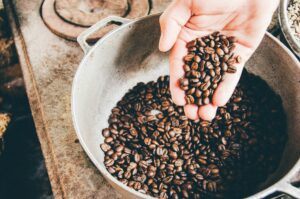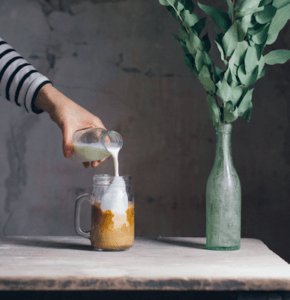If you’re trying to figure out how to seek out gourmet coffee reviews, you came to the right place.
What exactly makes a coffee, a “gourmet coffee?” How can you be sure that the specific price matches the quality of the beans? How do you even know if a brand of coffee is good quality?
While there is no universal agreement on what makes “gourmet coffee” there are attributes that help consumers determine good quality coffee versus average or plain bad coffee. Whether you’re trying to figure out if buying your local cafes beans is worth it, or if your friend’s small-batch beans are good – there are a few ways you can determine this.
While we can’t point out a singular factor of what makes a coffee special or “gourmet coffee,” we can point out several factors that go into the coffee’s specialty (or its lack of).
If you are new to coffee, or just want to refresh your knowledge about the coffee world, this article will guide you through the basics of gourmet coffee (and just coffee in general). We will address the following three factors:
- Different types of coffee beans
- Different attributes of a coffee
- Various processing methods
These factors can make or break your coffee, so it’s important to get to know each of them. Let us begin with the different types of coffee beans – Arabica and Robusta.
Different Types of Coffee Beans, According to Gourmet Coffee Reviews

One of the first things to consider when choosing your coffee is the type of coffee bean that you are working on.
The type of coffee bean matters as each creates a different body, taste, and aroma. Arabica and Robusta are the two most common types of coffee beans. Gourmet coffee reviews emphasize that it’s important to know their distinct characteristics.
Arabica
Arabica is the most common type of coffee bean accounting for over 60% of the world’s coffee production. There’s a high chance that if you have coffee beans in your cabinet right now, they are Arabica coffee beans.
Arabica beans usually have what is called a “bright body,” an average level of acidity, and a variety of aromas and flavors. The best Arabica beans are classified as full body and lower acidity, so try to search for that. An important thing to know about Arabica is that it’s best served hot and without much creamer – Arabica diminishes its quality when it’s served cold or when it has creamer.
Robusta
Robusta is second in the world’s coffee production, accounting for around 20% of it. The beans are probably called such because it is a strong-bean, and has been used in a variety of cultures to ward against diseases and relatively harsh conditions.
A high-quality Robusta bean usually has low acidity, smooth texture, and a flavor that hints of chocolate.
Unlike Arabica, Robusta is great for sugar and cream – so, if you love creamer, Robusta is a better coffee bean for you.
Different Attributes of a Coffee

Now that you know the two most commonly used coffee beans, it’s time to know the different attributes that make up a brand of coffee. These attributes usually come from the type of coffee bean and the quality of it, but your brewing method can affect it as well.
Gourmet coffee reviews detail that the different attributes that make (or break) your coffee are quality, acidity, body, and freshness.
Quality
Quality is the number one factor when it comes to determining your coffee’s, well, quality. The highest level of quality coffee beans can achieve is what is called “specialty coffee” (or, “gourmet coffee”). Specialty coffees are distinctive in the sense that they only grow under ideal situations – if you go deeper into this, you’ll understand why altitude, climate, diseases, etc. are very important in growing coffee beans because these contribute to the coffee’s quality.
If quality is important to you, you should know the background of the coffee bean you’re buying – not just its type, but how it was grown, in what climate, and other factors that may interest you. Or simply ask your roaster or go-to café about their minimum quality specification.
Acidity
Acidity is a specific characteristic to describe carrying foods and beverages. In regards to coffee, it’s often referenced as the coffee’s “brightness.” This ranges from bean to bean but can be predicted on the roast, with darker roasts tending to have lower acidity than lighter roasts from the same origin.
If you are conscious about your coffee’s acidity, it’s important to note this: coffee beans grown at higher altitudes are usually more acidic (again, perceived acidity) than those grown in lower altitudes, so you may want to consider the altitude at which your coffee bean was grown.
Body
Body, in terms of how we perceive it, is determined by the fullness of the flavor. Hence, the body is often called the coffee’s flavor.
The coffee’s body, aside from its beans, is also affected by the brewing method used. For instance, coffee brewed by French press tends to have a more robust flavor and fuller body than if that same coffee is slow drip-brewed with a paper filter.
To get the type of body or flavor you want, you may want to experiment with different brewing methods.
Freshness
This characteristic speaks for itself, the freshness of a coffee bean. A coffee’s freshness depends on the time elapsing between the coffees harvest, to its roasting, to its brewing. If you are looking for a fresh coffee, try to purchase a bag within 14 days after it was roasted.
To preserve your beans longer, keep them in the freezer.
Different Processing Methods

How your coffee is processed is the last factor that highly impacts your coffee’s quality, whether that is its brewing or roasting method. Keep in mind that different methods can affect the attributes or characteristics of your coffee, as mentioned above.
Now, there are not necessarily “better” ways to brew or roast your coffee; again, it depends on the outcome you desire for your coffee.
How a company processes your coffee impacts the body. For instance, the washed processing method removes its sugary fruit pulp, giving it a light to medium body and very clean, bright flavor. On the other hand, natural processing dries the beans, giving the beans a deeper-toned, more diverse, and heavier flavor.
Roasting Methods

Roasting methods can enhance or diminish your coffee bean’s distinct flavors.
So, how do you roast well? You will only learn that with experience, and if you want to explore different types of coffee beans, well, you have to work on each of them to learn how to roast them properly. If you are not looking into roasting yourself, you can always ask your go-to coffee brand what their roasting method is.
Brewing Methods

How you brew your coffee will impact its overall taste, flavor, and strength. Again, there’s no better way of brewing your coffee, just based on the outcome you want your coffee to have.
Should you brew with a French Press, have an Espresso, or use Drip Coffee? It depends on the outcome you want for your coffee, so, for the most part, you’ll only learn this with experience and experimentation.
Try it out — Vietnamese Iced Coffee

Vietnamese coffee is one of our favorite springtime treats. It’s a delicious mixture of coffee and condensed milk, bringing around a sweeter flavor palate. If you want an iced beverage without a sweet tone, then use coconut milk instead. If you prefer a very sweet drink, you can also add sugar to this beverage, but we recommend trying it as is first.
You brew traditional Vietnamese coffee by using a small metal drip filter. To get the right flavor, brewing methods mater! We suggest using that method as well, but if you don’t have a metal drip filter, you can brew with what you have.
Ingredients →
-
2 tablespoons dark-roast ground coffee
- 2/3 cup of water
-
2 tablespoons of sweetened condensed milk
How to make it →
- Steep coffee grounds in a heatproof container with 2/3 cup boiling water for 4 minutes. Pour through a coffee filter into a heatproof glass.
- Stir in condensed milk until consistent.
As you can see, the quality of your coffee is very subtle – a little mistake, from farming to timing to brewing can alter the quality of your coffee. Gourmet coffees stay consistently unique because of the care they receive.
If you want to make your own gourmet coffee or simply want to learn how to pick one at your favorite café, we hope that this guide to gourmet coffee reviews helps.
Now that you’ve learned how to choose great coffee, through our gourmet coffee reviews, check out one of our latest posts on buying quality coffee online. You can also shop for our coffee here.


